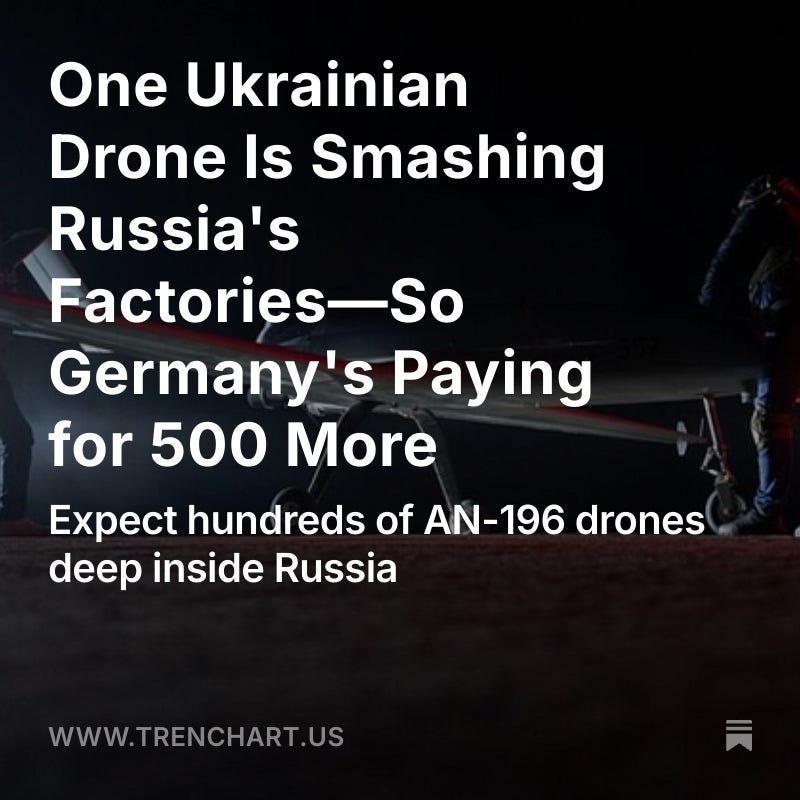Ukraine's Drones Droned In—And 2 of Russia's Biggest Refineries Exploded
Aug. 2 oil targets account for 8% of Russian refining
Ukrainian drones motored across Russia on Saturday morning and struck oil refineries in Ryazan and Novokuibyshevsk, respectively 320 miles and 650 miles from Ukraine.
The Ryazan refinery, which has come under attack before, is responsible for as much as 5% of Russian refining. Ryazan is one of the bigger oil targets Ukrainian drones and missiles have hit since September 2023. Total Russian refinery output is around 300 million tons a year.
The hit on the Novokuibyshevsk refinery, which may have struck a vulnerable and hard-to-repair distillation tower, sent a fireball billowing into the sky. (See video.) The Novokuibyshevsk facility accounts for around 3% of annual refining in Russia.
After a months-long lull, Ukraine’s campaign targeting Russia’s most important industry is back on, it seems.
Ukrainian forces are much better-equipped than they were just a few months ago for long-range attacks on Russian oil—with Ukroboronprom An-196 drones, Bars cruise missiles and potentially even a new radar-jamming drone that can escort the An-196s and Bars into Russian air space.
Germany is underwriting the drone and missile production.
Through much of last year, Ukrainian deep strikes mostly targeted Russian ammunition depots. But the raids didn’t have much measurable effect on the front line.
Even when a drone attack triggers an impressive explosion, it may “leave overall functionality intact” at a given depot, Ukrainian analysis group Frontelligence Insight explained. And besides, even deprived of some ammo shipments, Russian regiments outnumber and outgun Ukrainian brigades along the 700-mile front line.
“Long-range strikes … by themselves were not decisive, and could not solve the challenges observed on the modern battlefield,” noted Michael Kofman, a senior fellow in the Russia and Eurasia Program at the Carnegie Endowment for International Peace in Washington, D.C.
Shift to oil targets
Ukrainian planners came to the same conclusion as 2024 ground into 2025. “The strikes gradually shifted to oil or gas storage facilities and oil and gas refineries,” Frontelligence Insight observed. “In January, two-thirds of all verified strikes were directed at them.”
There was a cold logic behind the shift. For starters, there are plenty of refineries and oil and fuel storage sites and pipeline pumping stations within easy reach of Ukraine’s deep-strike force. And where the Russian munitions industry and its supporting logistical networks are robust, the Russian oil industry is fragile.
Strikes on Russian oil refineries in late 2024 and early 2025 depressed Russia’s production of petroleum products—most importantly, gasoline—by as much as 10%, with cascading effects on Russian military logistics and exports.
“These cascading effects, which erode Russia’s economic resilience, increase operational costs and expose vulnerabilities in its energy-dependent war economy,” said Olena Lapenko, general manager on security and resilience at the DiXi Group think tank in Kyiv.
With a growing stable of drones and missiles capable of reliably traveling hundreds of miles inside Russia, Ukraine can hold at risk much of the most important machinery of Russia’s wartime economy.
The Ukrainians can hit the Russians where it really hurts—and inflict what Lapenko called “systemic stress.” As more drones launched starting last fall, Russian leaders panicked. In March, they agreed to halt strikes on Ukrainian power plants if the Ukrainians would halt strikes on Russian refineries.
The March 18 moratorium on energy attacks, which both sides more or less respected, expired a month later on April 18. But months later, neither side had resumed attacks on the other’s energy infrastructure.
In a war defined by wanton Russian aggression, the Russians were compelled to exercise at least some restraint—because they knew the Ukrainians could wreak havoc on a $189-billion industry.
The Saturday raids may signal the Ukrainians are no longer interested in the energy-raid detente. And if so, it’s not hard to guess why. Russian strikes on Ukrainian cities have become more frequent and much more destructive in recent months.



